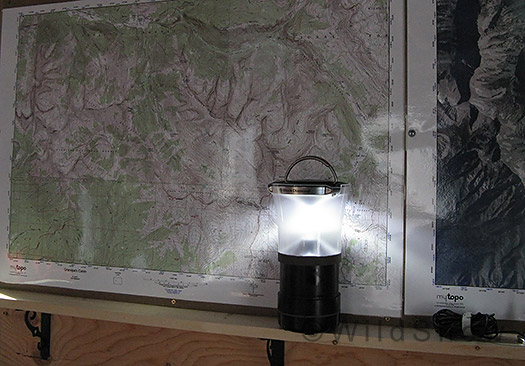Prior to completing our portahut solar system, we used electric lanterns and headlamps for lighting. We still use that stuff for convenience and mood, so I’m always up for improvements in the portable lighting category.

Black Diamond Titan Lantern at the portahut map wall.
Some time ago I tried some supposedly bright electric lanterns I sneaked out of Wally World when no one was looking (yes, let the jeering commence). Alas, the meager light from those junkers is more like the phosphorescence of a single firefly, rather than lumens one can actually use for more than a romantic interlude (not that interludes aren’t important, but hey, one eventually has to do the dishes, too). And battery life? More like battery death.
Thus, I was about ready to give up on electric lanterns when I tried a Black Diamond Titan. Yep, bright. Simple switch that when held in dims down smoothly. Excellent battery life (how do they do that?). Top part slides down to collapse for packing, hang loops work well. It even looks nice. Downside is Titan does use D cells, has no stock recharging option, and lacks a 12 volt power jack for automobile or typical solar aux power input. Thus, if you put lots of hours on this lantern you might be wise to purchase rechargeable D cells and a charger. Those quibbles aside, overall this unit is very impressive for the under $70 street price. If you know someone who’s trying to get away from gas lanterns for camp or hut, remind them to give the Titan a whirl. Simply put, it works.
WildSnow.com publisher emeritus and founder Lou (Louis Dawson) has a 50+ years career in climbing, backcountry skiing and ski mountaineering. He was the first person in history to ski down all 54 Colorado 14,000-foot peaks, has authored numerous books about about backcountry skiing, and has skied from the summit of Denali in Alaska, North America’s highest mountain.
